Zaha Hadid and Feel-Good Modern Organic Structures
By Eveline Morel | November 20th, 2012 | Category: L.A. Art & Culture | Comments Off on Zaha Hadid and Feel-Good Modern Organic Structures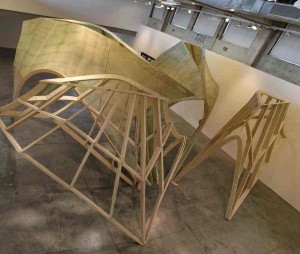
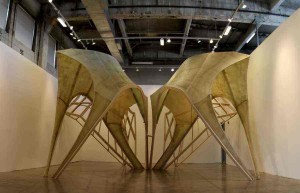 The pleated shell structures at the Zaha Hadid installation at Sci Arc seemed like something straight out of one of Masamune Shirow’s anime visions of utopian cities: organic, futuristic shapes, half-plant, half-egg-shaped, that seem to have sprouted up from the ground. This prototype explores the creation of new physical shapes and draping of materials (i.e. cloth, chains, and fiberglass) over mathematically-generated structural wood skeletons.
The pleated shell structures at the Zaha Hadid installation at Sci Arc seemed like something straight out of one of Masamune Shirow’s anime visions of utopian cities: organic, futuristic shapes, half-plant, half-egg-shaped, that seem to have sprouted up from the ground. This prototype explores the creation of new physical shapes and draping of materials (i.e. cloth, chains, and fiberglass) over mathematically-generated structural wood skeletons.
The prototype combines and further explores a number of structural design methods pioneered by other architects: Antonio Gaudi’s geometric translations of natural shapes; Heinz Isler’s and Felix Candela’s structural engineering and development of thin concrete shell structures; and Frei Otto’s use of tensile and membrane structures in architecture, as well as structural mathematics.
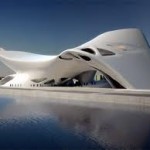 She takes her cues and inspiration from nature, primarily landscape, topography, and geological patterns. As she says, her childhood experiences in southern Iraq’s villages on the marshes have continued to influence her: “the beauty of the landscape—where sand, water, reeds, birds, buildings, and people all somehow flowed together—has never left me.” Her structures always have a sense of motion; her structures are always dynamic rather than static, like a controlled explosion. Another source of inspiration is the language of highway engineering, with separating and intersecting of motorways and traffic flow patterns. She integrates natural and human-made systems, using the latest technology, digital imaging, and physical modeling to create unexpected and dynamic architectural forms that mold into the landscape. As she says, “I like architecture to have some raw, vital, earthy quality.”
She takes her cues and inspiration from nature, primarily landscape, topography, and geological patterns. As she says, her childhood experiences in southern Iraq’s villages on the marshes have continued to influence her: “the beauty of the landscape—where sand, water, reeds, birds, buildings, and people all somehow flowed together—has never left me.” Her structures always have a sense of motion; her structures are always dynamic rather than static, like a controlled explosion. Another source of inspiration is the language of highway engineering, with separating and intersecting of motorways and traffic flow patterns. She integrates natural and human-made systems, using the latest technology, digital imaging, and physical modeling to create unexpected and dynamic architectural forms that mold into the landscape. As she says, “I like architecture to have some raw, vital, earthy quality.”
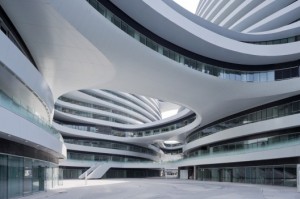 Born in Baghdad, she studied at the Architectural Association in London and was a partner in the Office of Metropolitan Architecture with Rem Koolhaas. She was awarded the Pritzker Architecture Prize (considered to be the Nobel Prize of Architecture) in 2004. Part of Forbes “100 Most Powerful Women,” she is internationally recognized for both her theoretical and academic work, and has completed projects around the world. She heads Zaha Hadid Architects, a 250-person firm in London. Her design projects include the Cincinnati Art Museum, Abu Dhabi Performing Arts Center, the Guggenheim-Hermitage in Vilnius, Lithuania; the JS Bach Pavilion in Manchester, UK ; the Burnam Pavilion in Chicago; the Bridge Pavilion in Zaragosa, Spain; and most recently, the London Aquatics Centre, completed in time for the 2012 Olympics. In November 2012, Zaha Hadid just celebrated the completion of the Galaxy Soho complex in Beijing China.
Born in Baghdad, she studied at the Architectural Association in London and was a partner in the Office of Metropolitan Architecture with Rem Koolhaas. She was awarded the Pritzker Architecture Prize (considered to be the Nobel Prize of Architecture) in 2004. Part of Forbes “100 Most Powerful Women,” she is internationally recognized for both her theoretical and academic work, and has completed projects around the world. She heads Zaha Hadid Architects, a 250-person firm in London. Her design projects include the Cincinnati Art Museum, Abu Dhabi Performing Arts Center, the Guggenheim-Hermitage in Vilnius, Lithuania; the JS Bach Pavilion in Manchester, UK ; the Burnam Pavilion in Chicago; the Bridge Pavilion in Zaragosa, Spain; and most recently, the London Aquatics Centre, completed in time for the 2012 Olympics. In November 2012, Zaha Hadid just celebrated the completion of the Galaxy Soho complex in Beijing China.

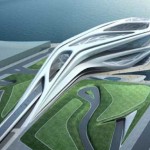 Zaha Hadid’s works, never ordinary, are aesthetically visionary pieces that seamlessly combine the avant-garde futuristic with organic curves and shapes that maintain a dynamic harmony. Her architecture and product designs, although streamlined and very futuristic, have a “natural” quality to them that feels familiar and somehow welcoming, and create a positive feeling of well-being. In her words, “Architecture is really about well-being. I think that people want to feel good in a space . . . On the other hand, it’s about shelter, but it’s also about pleasure.”
Zaha Hadid’s works, never ordinary, are aesthetically visionary pieces that seamlessly combine the avant-garde futuristic with organic curves and shapes that maintain a dynamic harmony. Her architecture and product designs, although streamlined and very futuristic, have a “natural” quality to them that feels familiar and somehow welcoming, and create a positive feeling of well-being. In her words, “Architecture is really about well-being. I think that people want to feel good in a space . . . On the other hand, it’s about shelter, but it’s also about pleasure.”
Couldn’t agree more . . .








